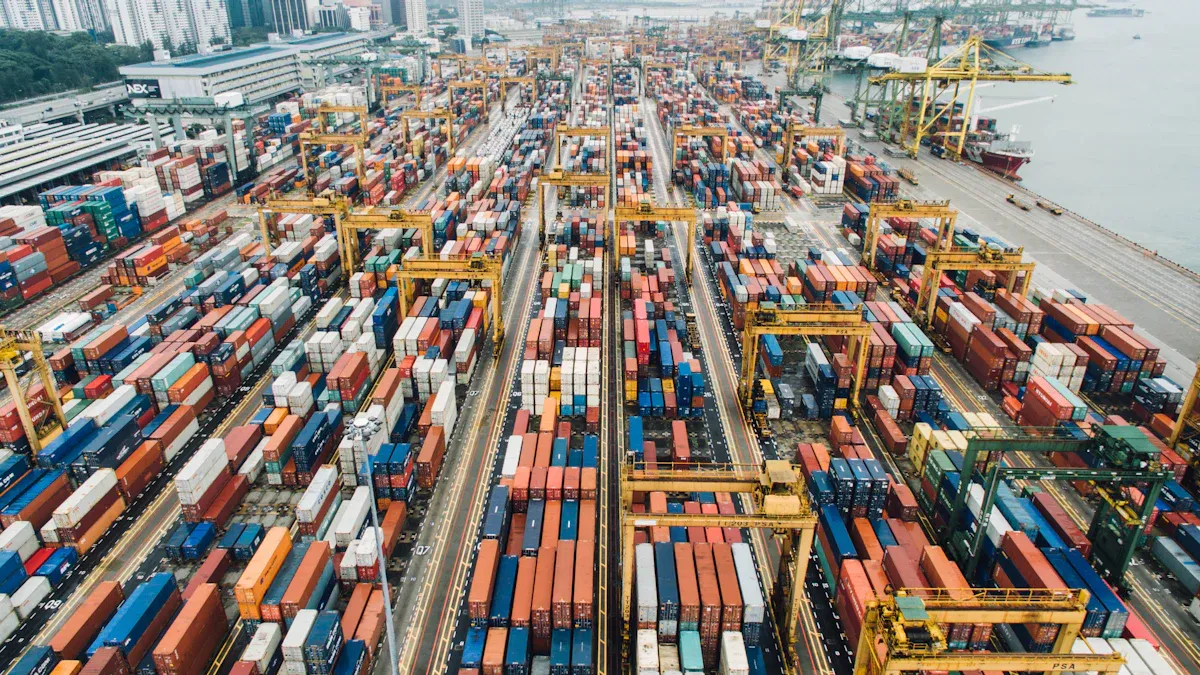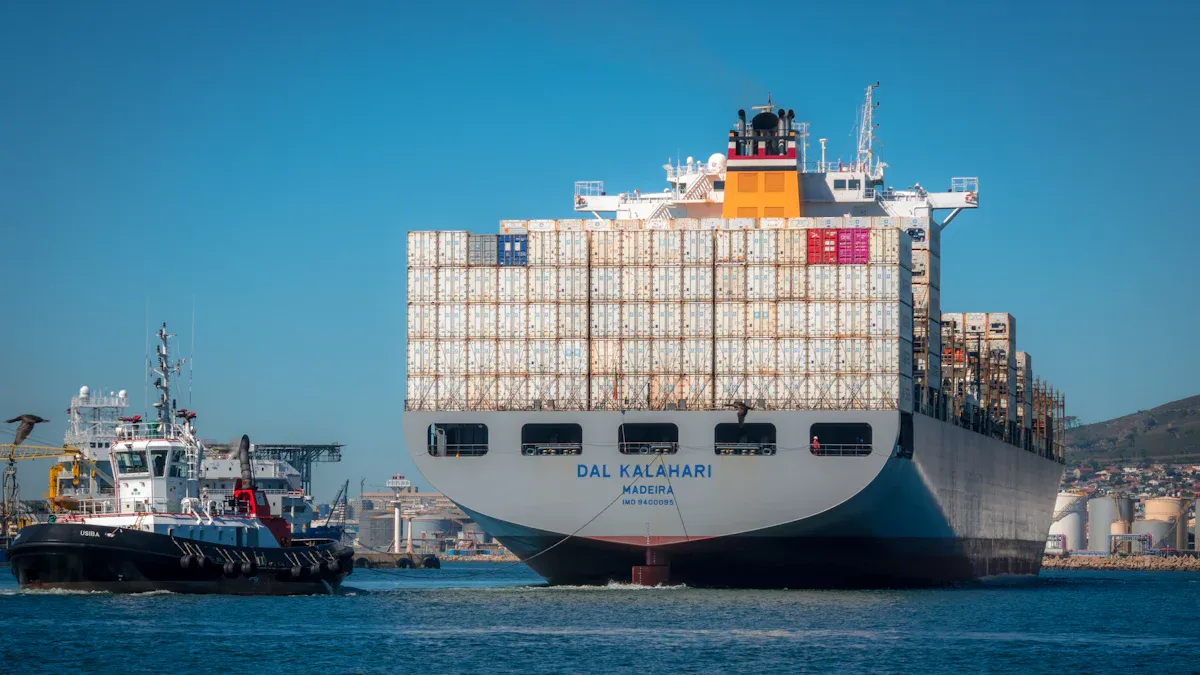How to Choose the Right Ocean Freight Solution for Your Business in 2025

You pick the best shipping method by looking at what your business needs. Ocean freight solutions help save money and keep things running well. They also help you follow the rules. Using digital tools and green ideas in ocean freight makes shipping smarter. The right ocean freight solution helps your shipping business get bigger.
Key Takeaways
Pick the right shipping method for your cargo type, how much you ship, and how fast you need it. This helps you save money and keeps your business working well. - Pick full container loads (FCL) if you have a lot to ship. Pick less-than-container loads (LCL) if you have less to send. Think about cost, speed, and how much control you want. - Use digital tools like real-time tracking and smart planning. These tools help you trust your shipments, stop delays, and follow green shipping rules.
Assess Shipping Needs
Cargo Type & Volume
Start by checking what you are shipping. Electronics, automotive, and FMCG need different things. Electronics are things like phones and laptops. Automotive shipping is for cars, trucks, and parts. FMCG can be clothes, home goods, or food. Ocean freight is good for big or heavy shipments. It is also good if you do not need fast delivery. In 2023, over 11 billion tons were shipped worldwide. Electronics and automotive made up a lot of this. If you ship things that can spoil, you need special containers. JUSDA’s warehouse solutions help keep your goods safe before shipping.
Frequency & Urgency
Think about how often you ship and how fast it must arrive. If you ship a lot and often, use full container loads. This gives you more control and saves money. If you ship less or in small amounts, use less-than-container loads. This can save money but may take longer. If you need things fast, use premium or express ocean freight. These cost more but are quicker. Real-time tracking helps you see where your goods are. Backup plans help if there are delays.
Budget & Service Level
Decide your budget before picking a freight solution. In 2025, ocean freight costs are going up. Premium services cost about 25% more than normal ones. Your budget will help you choose the right service. Top providers raise rates and manage space to keep prices steady. You need to balance your budget, service, and shipping needs. JUSDA’s warehouse and digital tools help you save money and manage goods. Always match your budget to your shipping goals. Be ready for changes in costs.
Compare Ocean Freight Solutions

FCL vs LCL
When you look at ocean freight solutions, you often pick between FCL and LCL. Each one works best for different shipping needs. FCL means you get the whole container for your own goods. LCL means you share the container with other people’s goods. The table below shows how they are different:
Factor | LCL (Less-than-Container Load) | FCL (Full Container Load) |
|---|---|---|
Container Usage | Shared container space among many shippers | Exclusive use of entire container by one shipper |
Cost Model | Pay by volume (CBM); lower upfront cost, but can rise with size | Fixed rate per container; better for large shipments |
Transit Time | Slower, more handling and possible delays | Faster, direct route, less handling |
Capacity | Best for under 15 CBM or 2-3 pallets | Best for 15 CBM or more |
Security | More handling, higher risk | Sealed from start to end, lower risk |
You should choose FCL if you have a lot to ship or want more control. LCL is good for smaller loads or when you do not fill a container.
Specialized Sea Freight Shipping
Some ocean freight shipping needs special solutions. Ro-Ro shipping is best for cars and big machines that roll on and off the ship. This way saves time and helps stop damage. Reefer containers keep things cold or frozen. They are great for food, medicine, and other things that spoil. If you need to ship cars, trucks, or things that can go bad, these choices help keep your cargo safe and fresh.
JUSDA’s Digital Freight Shipping Solution
JUSDA has digital ocean freight solutions that make shipping simple. With JusLink, you can track your goods in real time and manage your inventory. You can always know where your goods are. JUSDA’s worldwide warehouse network gives you many sea freight solution choices, like FCL, LCL, and consolidation. This network lets you grow or shrink your shipping as your business changes. You also get help with customs, fast container handling, and steady shipping routes. These digital sea freight solutions help you handle changes and keep your supply chain strong.
Tip: Use digital tools to compare ocean freight solution choices and track your goods for better results.
Choose the Appropriate Freight Solution
Key Factors: Cost, Time, Reliability
When you choose an appropriate freight solution, you need to look at three main things: cost, speed, and reliability. Each factor affects how your shipping works and how happy your customers feel.
Factor | Ocean Freight (2025) | Air Freight (2025) |
|---|---|---|
Cost | $2,000–$5,000 per 40' FCL; < $100 per CBM for LCL; extra port, drayage, and handling fees | $4–$12+ per kg; fewer hidden fees |
Speed | 12 to 40+ days; LCL takes longer | 1 to 7 days |
Reliability | Can change with port congestion, weather, or events | High; less affected by delays |
Cargo Type | Bulky, heavy, non-urgent goods | Time-sensitive, high-value goods |
You should pick ocean freight for large, heavy goods that do not need fast delivery times. Air freight works better for urgent or high-value shipments. LCL shipping has lower base rates but adds extra costs like handling fees. FCL shipping costs more upfront but gives you better control and fewer delays. Always check for hidden shipping costs and think about how long your goods will be in transit.
Reliability matters a lot. Port congestion, weather, and global events can slow down ocean freight. You need to plan for these risks. Using real-time data and trusted market information helps you manage costs and keep your shipping on track. Carrier reliability is key for on-time delivery. If you want fewer delays, choose providers with strong records for on-time delivery.
Technology & Tracking
Technology now plays a big role in ocean freight. Digital tools like IoT, cloud computing, and blockchain make shipping faster and more reliable. These tools help you track your goods in real time, so you always know where your shipment is. Real-time tracking lets you spot problems early and fix them before they cause big delays. For example, many companies saw customer satisfaction rise by 30% after adding live shipment updates.
Platforms like JUSDA’s JusLink give you full visibility of your supply chain. You can see your goods move from warehouse to port and all the way to the final stop. This helps you plan better and avoid mistakes. Automation and digital records also cut down on paperwork and reduce errors. When you use these tools, you get better on-time delivery and lower shipping costs.
Many global shippers now use AI and data analytics to pick the best routes and improve speed. Automation in ports and warehouses speeds up cargo handling and cuts costs. Blockchain adds security and trust by making records that cannot be changed. These changes make your freight more reliable and help you meet new rules for green shipping.
Checklist for Decision-Making
Use this checklist to match your needs to the right ocean freight solution:
Know Your Goods
Are your goods bulky, heavy, or non-urgent?
Do they need special care, like cold storage?
Check Shipping Volume and Frequency
Do you ship often or in large amounts?
Would FCL or LCL fit your needs better?
Set Your Budget
What is your total budget for shipping costs?
Have you included all extra costs like handling and customs?
Decide on Speed
How fast do your goods need to arrive?
Can you wait for longer delivery times to save on costs?
Review Reliability
Does your provider have a good record for on-time delivery?
Can you track your shipment in real time?
Use Technology
Are you using digital tools for tracking and planning?
Does your provider offer real-time updates and automation?
Think About Sustainability
Are you meeting new green shipping rules?
Is your provider investing in cleaner ships and fuels?
Avoid Common Mistakes
Automate order fulfillment to cut down on errors.
Build strong partnerships with reliable carriers.
Tip: JUSDA’s supply chain management platform and warehouse services help you manage all these steps. You get real-time tracking, smart planning, and support for every part of your shipping process.
When you follow this checklist, you can choose the most appropriate freight solution for your business. You will balance cost, speed, and reliability, and you will avoid common shipping mistakes. This helps you keep your goods moving and your customers happy.

JUSDA Solutions
To provide you with professional solutions and quotations.
You can find the best ocean freight solution by looking at what your business needs. Match your shipping needs with your business goals. Use digital tools to get quotes and track your shipments. Ask experts like JUSDA for help with freight forwarding and supply chain advice. Check your shipping plan often. Market changes and global trade rules can change shipping costs and how well things move.
